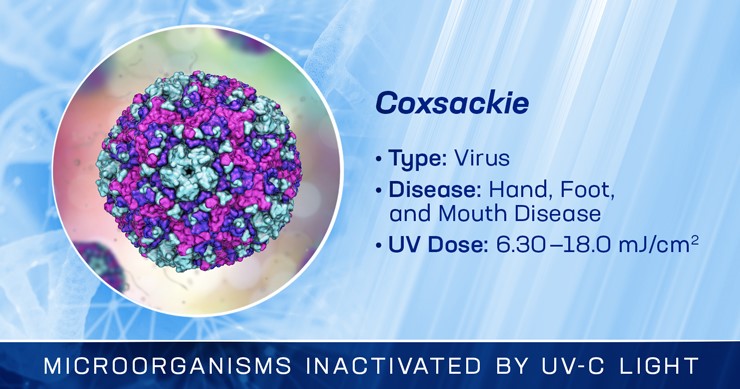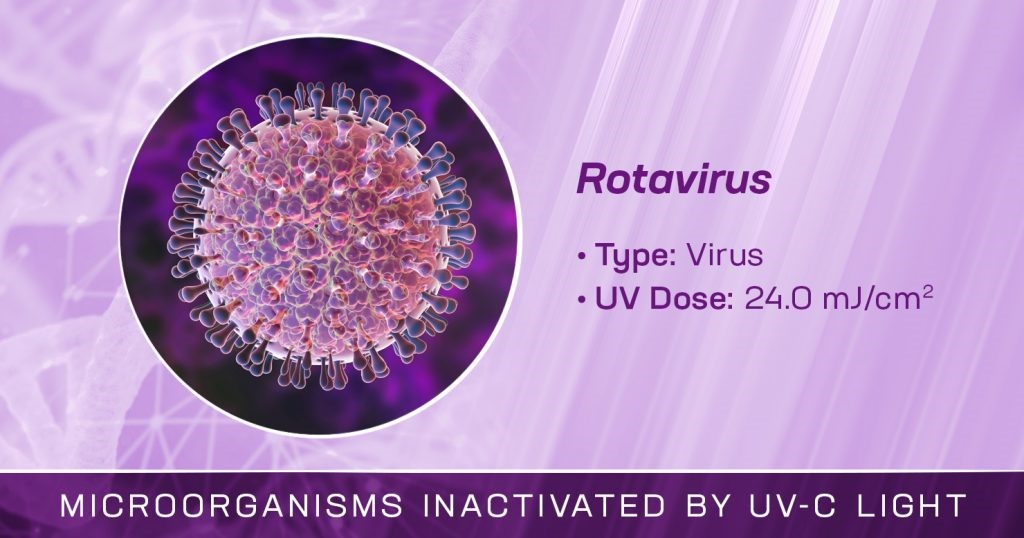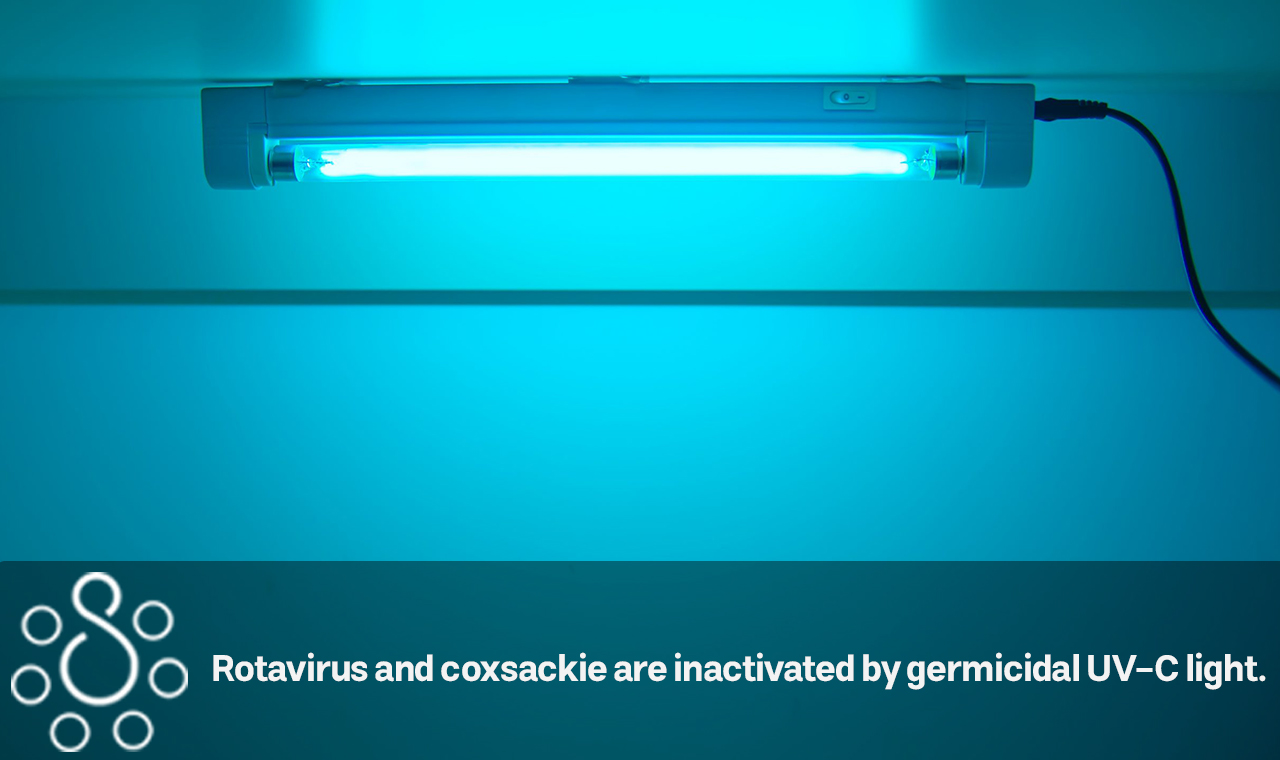Viruses are obligatory parasites, which means that they cannot replicate or spread outside of the cells that they infect. It is possible for surfaces in the environment to get infected with viruses either via direct contact with infectious bodily fluids or by the settling of airborne viral particles. In order for surfaces to function as sources of viral illness, the virus in question has to be able to persist in association with the surface until it comes into contact with a host that is vulnerable to the disease. Surface transmission has been linked to the spread of viruses like the hepatitis virus, rotavirus, enterovirus, and severe acute respiratory syndrome coronavirus, which has led to a number of viral epidemics. To make the most use of this knowledge, we must find out how UV-C light inactivated Rotavirus and Coxsackie.
Heating sterilization, ultraviolet germicidal irradiation, and chemical disinfectants are a few examples of the various control strategies that might lower the danger of viral infection from surfaces. But many of the materials on the surface can’t be sterilized with heat, and the chemical disinfection process could hurt them.
UV-C Light Has the Capability to Defeat the Coxsackie Virus
In contrast to the majority of disinfectants, ultraviolet germicidal irradiation (UVGI) has gained widespread recognition as an efficient approach for eliminating bacteria. Because the maximal wavelength of absorption of a DNA molecule is 260 nm, the mechanisms of UVGI on bacteria are especially susceptible to light with wavelengths at or around 253.7 nm. This is because of how light interacts with DNA.
The DNA sequence of microorganisms when subjected to UV irradiation has the potential to generate pyrimidine dimers. This has the potential to impede the process of DNA replication as well as result in the destruction of nucleic acids and make viruses noninfectious.
Related Article: Learning to use and set up Surya Professional disinfectant with UV-C sterilizer box
What is this disease known as Coxsackie?
Hand, foot, and mouth disease is caused by a virus called Coxsackie, and its symptoms include a rash that looks like blisters and can appear on the hands, feet, or mouth. Children younger than 10 years old are most likely to become infected with the disease, and infections in children younger than 5 years old are very common. Opens in a New Window It is possible for it to happen to young adults on occasion.
The viruses that cause hand, foot, and mouth disease (HFMD) are members of the family Enterovirus, which can be seen by clicking this link to open a new window. In the United States, the coxsackievirus A16 is typically the culprit behind the majority of cases of HFMD. There is a possibility that the coxsackievirus A6 will cause a more severe illness.
Stopping the Further Spread of the Coxsackie Virus
According to the Centers for Disease Control and Prevention (CDC), the coxsackie virus is usually spread by close contact with an infected person’s:
- Discharges from the nose and throat (such as saliva, drool, or mucus from the nose): When a sick person coughs or sneezes, droplets of respiratory secretions that may contain virus particles are released into the air.
- Fluid from sores or blisters: through close contact such as kissing, hugging, or sharing cups or eating utensils with an infected person.
- when changing diapers, for example, and then touching your face, including your eyes, nose, or mouth.
The Hand, Foot, and Mouth Disease can also be contracted by touching objects and surfaces that are contaminated with the virus, such as doorknobs or toys, and then touching one’s eyes, nose, or mouth. Children who are showing symptoms of illness or have a fever should not participate in any group activities until their temperature has returned to normal and they have no further symptoms.
It is imperative to perform thorough hand washing and surface disinfection, particularly after changing a diaper, using the restroom, blowing one’s nose, coughing, or sneezing. Those who have hand, foot, and mouth disease are typically at their most contagious during the first week of their illness.
[Case in point] People can sometimes spread the virus to others for days or weeks after their symptoms have gone away, or even if they have no symptoms at all. This can happen even if they haven’t been exposed to the virus themselves. It is known that the virus can survive in the stool for up to several weeks after it has been shed.
Related Article: Is UV-C light harmful for air ducts and electronics?
Germicidal UV disinfection will provide you with a higher level of protection.
In addition to the preventative measures listed above, the use of germicidal ultraviolet-C (UV-C) surface disinfection (at the dosage listed below) has been shown to be effective in deactivating the Coxsackievirus in a variety of settings, including medical facilities, educational institutions, and daycare centers.
Our products make use of STER-L-RAY® Germicidal UV-C Lamps, which are responsible for producing ultraviolet wavelengths at 254 nanometers. This is the region of germicidal effectiveness that is the most destructive to harmful microorganisms like Coxsackie.
If someone drinks contaminated water while participating in recreational activities such as swimming, the coxsackievirus has a remote chance of spreading. If the water has not been properly disinfected and it contains fecal matter from a person who has hand, foot, or mouth disease, then this could occur. Using our germicidal ultraviolet water purifiers can help protect swimming pools against a wide range of disease-causing microorganisms.

| rganism: | Alternate Name: | Type: | Disease: | UV Dose*: |
| Coxsackie A2 | — | Virus | Hand, Foot, and Mouth Disease, Conjunctivitis, Meningitis | 6.30 mJ/cm2 |
| Coxsackie A10 | — | Virus | Hand, Foot, and Mouth Disease, Conjunctivitis, Meningitis | 8.90 mJ/cm2 |
| Coxsackie B1 | — | Virus | Myocarditis, Pericarditis, Pneumonia, Meningitis, Encephalitis, Hepatitis | 17.0 mJ/cm2 |
| Coxsackie B3 | — | Virus | Myocarditis, Pericarditis, Pneumonia, Meningitis, Encephalitis, Hepatitis | 16.0 mJ/cm2 |
| Coxsackie B4 | — | Virus | Myocarditis, Pericarditis, Pneumonia, Meningitis, Encephalitis, Hepatitis | 13.0 mJ/cm2 |
| Coxsackie B5 | — | Virus | Myocarditis, Pericarditis, Pneumonia, Meningitis, Encephalitis, Hepatitis | 18.0 mJ/cm2 |
Related Article: What UV light is best for plants
The UV-C Light That Is Germicidal Is Capable of Deactivating Rotavirus.
What exactly is this rotavirus doing?
The rotavirus is an infectious disease that most commonly affects infants and young children under the age of five and can cause intestinal disease. If they do become infected, adults are more likely to experience a milder form of the illness.
The disease has a seasonal pattern that occurs during the winter and spring in countries with a temperate climate, such as the United States and other countries. Annual epidemics take place between the months of January and June
Stopping the Further Distribution of Rotavirus
The following are some of the ways that rotavirus can spread; opens in a new window:
- Ingestion of Rotavirus is through contaminated food or water.
- Putting your unwashed, feces-stained hands into your mouth is a surefire way to get sick.
- Putting contaminated objects or surfaces on your hands and then putting those hands in your mouth can spread disease.
Those who have rotavirus in their bodies will expel the virus in their stool. This is how the virus spreads throughout the environment and can cause infection in other individuals. Important preventative measures include maintaining proper hand hygiene and disinfecting surfaces on a regular basis. As a result of the fact that this virus can be found in water that is contaminated, purifying water in an appropriate manner is an essential component in preventing the spread of rotavirus.
Because they have the potential to be a source of rotavirus infection, it is important that domestic wells be tested on a regular basis and that they be properly maintained.
It is important to disinfect swimming pools and any other water sources used for recreational purposes. This virus can also be passed from person to person through food, either as a result of poor hand hygiene among those who handle food or as a result of raw produce being irrigated or washed with contaminated water. It opens in a new window Be sure to give all of the fruits and vegetables a thorough cleaning under running water, and make sure the meat is cooked completely.
Related Article: Air Filtration and UV Disinfection Greatly Reduce Viruses in Hospital Wards
Germicidal UV disinfection will provide you with a higher level of protection.
In addition to the preventative measures described above, germicidal ultraviolet-C (UV-C) surface disinfection has the potential to render rotavirus dormant in a variety of contexts. Our products make use of STER-L-RAY® Germicidal UV-C Lamps, which are responsible for the production of ultraviolet wavelengths at 254 nanometers. This is the part of the germicidal effectiveness where harmful microorganisms are hurt the most.
Rotavirus can be killed through the use of germicidal ultraviolet (UV-C) technology to purify drinking water or water that is used for the preparation of food. You can get more information about how UV purification can help protect your well water against rotavirus and many other harmful microorganisms by viewing our application page on well water contamination.
Germicidal ultraviolet radiation can be used to disinfect swimming pools and other recreational water sources, thereby rendering them resistant to a wide range of pathogens. The use of UV-C disinfection on surfaces that have the potential to be contaminated will also render this virus inactive. Please refer to the dosage information that is listed below.

| Organism: | Alternate Name: | Type: | Disease: | UV Dose*: |
| Rotavirus | — | Virus | — | 24.0 mJ/cm2 |
Related Article: Does UV-C light damage N95 masks?

